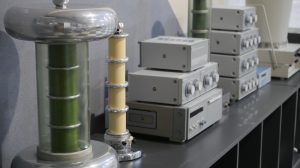GScan’s technology enables it to ‘see inside’ objects made of concrete, steel, and composite materials. No other current technology in the market enables that, opening whole new horizons in how ageing infrastructure useful life can be extended.
Estonian deep tech firm GScan, whose technology enables non-intrusive scanning of materials and structures, has raised a three million euros seed round from investors including Bolt-founder Markus Villig, Japanese corporate venture funds and existing angel investors.
- Defence tech in CEE takes centre stage
- Taiwan’s strategic opportunity in Central and Eastern Europe
- For Czechia, a third unicorn: Hotel SaaS firm Mews
“Muon tomography is decades old technology and with the advent of AI and better optical solutions, we have finally managed to commercialise and make viable non-invasive detection of defects faults in various materials, including concrete and steel,” says CEO Marek Helm.
“We have also launched the SilentBorder initiative to use muon tomography in finding for example narcotics and other contraband inside shipping containers without manual inspection. The advantage of muon tomography over x-rays is also that there is no harmful radiation.”
Founded by a team of CERN physicists, engineers, and entrepreneurs, GScan uses muons—naturally occurring, harmless cosmic rays—and AI analysis to assess the chemical composition and structural integrity of infrastructure, such as bridges and tunnels.
“The scientific innovations of our team allow for a detailed and non-invasive risk analysis of almost any structure, helping to identify structural weaknesses before they become critical,” says Helm.
The deep tech start-up provides detailed 3D imagery of assets’ internal structure, enhancing public safety through informed infrastructure maintenance.
GScan is currently working on a maiden project with the UK National Highways, AtkinsRealis, and Jacobs, assessing the integrity of steel components inside a post-tensioned concrete bridge.
Saving CO2
Concrete is the most abundant and CO2-heavy building material. Repairing an old structure instead of replacing it reduces the costs and CO2 by up to 80 per cent. For example, instead of demolishing and rebuilding one average bridge more than 460 tonnes of CO2 can be saved through prolonging its lifecycle.
In partnerships with academic institutions—including Imperial College London, the University of Sheffield, CERN, and the European Space Agency—GScan is exploring further applications of the technology in areas such as defence, national security, healthcare and space.
GScan was founded in 2018, and the company employs over 35 staff. In its first major commercial project, the firm scanned through 10 metres of concrete and steel for details of two Soviet-era nuclear submarine reactors in Paldiski, Estonia.
Achieving accuracies 30 times better than those of the former similar projects, GScan set a new benchmark for non-invasive imaging for complex legacy structures.
“We have already been invited to evaluate the potential of inspecting other ageing nuclear reactors in Europe,” adds Helm.
Photo by David Martin on Unsplash.
Unlike many news and information platforms, Emerging Europe is free to read, and always will be. There is no paywall here. We are independent, not affiliated with nor representing any political party or business organisation. We want the very best for emerging Europe, nothing more, nothing less. Your support will help us continue to spread the word about this amazing region.
You can contribute here. Thank you.







Add Comment